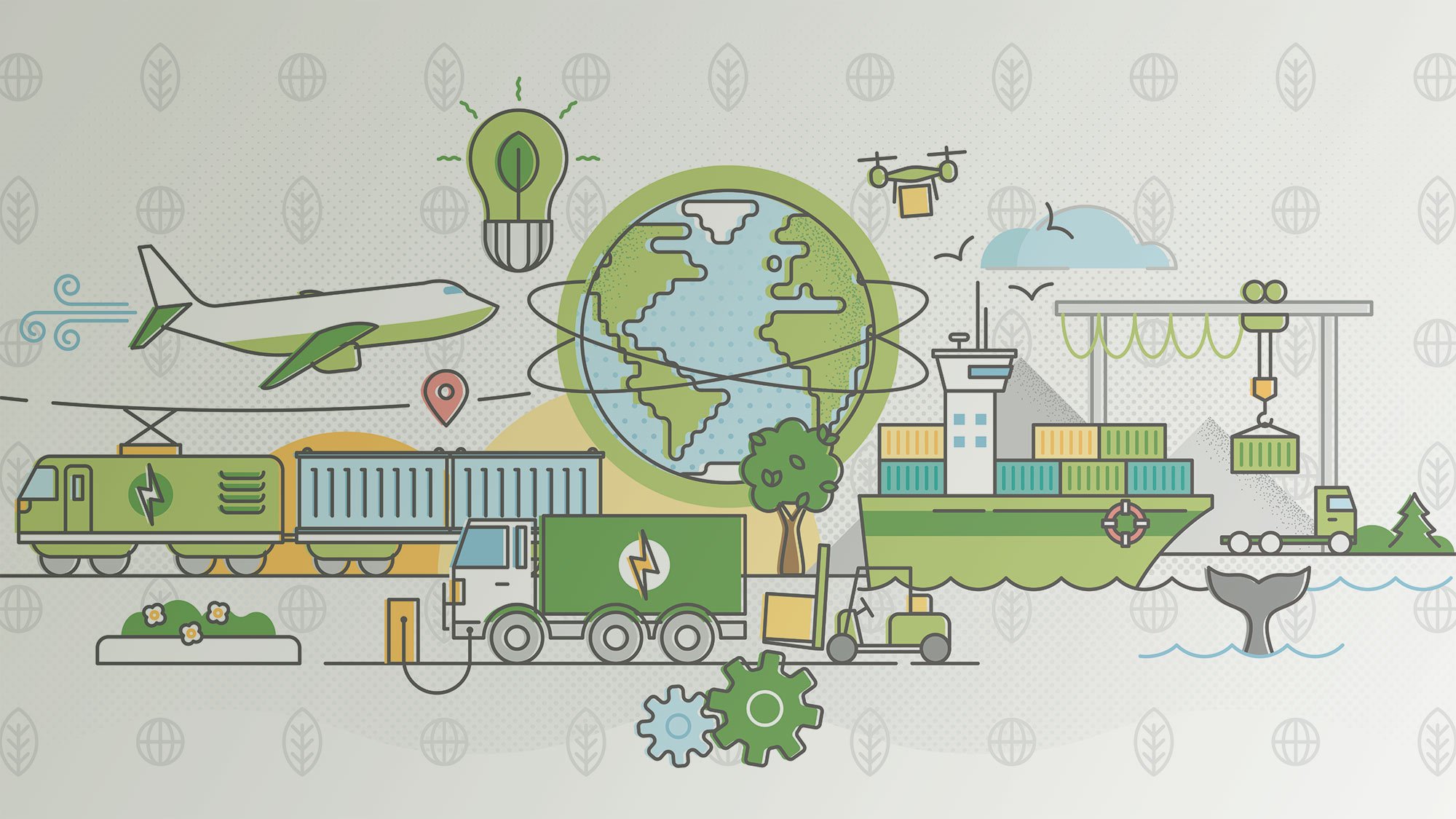The climate crisis manifests as a different set of challenges, depending on which kind of business you’re running. In the last few decades, trends like globalisation and the development of ecommerce, have led to considerable growth in the transport, logistics and warehousing sector of the economy.
Here in the UK, Office of National Statistics figures show that the sector has grown by 88% in the 10 years to 2021 with 21% growth between 2019–2021 alone. This acceleration has been mainly fuelled by Brexit, the COVID-19 pandemic and has yet to plateau since the pandemic ended. With this growth has come greater scrutiny on the business practices and emissions produced by the sector. We have seen an incredibly efficient, consumer-facing industry develop – but is it sustainable (in all senses) in the long-term?
Signals from the big players
As the world’s biggest retailer, what Amazon does tends to be seen as a useful guide to the future for everyone else. In the last decade, the company has been transitioning its delivery fleets, trialling and testing electric vans in the US before a global rollout. Their commitment? To move its entire 100,000+ van fleet to electric drive train vehicles by 2030 – and they already have Rivian electric vans delivering goods in 800 locations.
Of course, Amazon has deep pockets to make such an investment. But even they have encountered issues that small players might have anticipated. In 2022, it was found that £2m worth of electric vans in Glasgow were unused for weeks as there were insufficient chargers available for use at the depot. With consumer habits continuing to drive demand for delivery retail, this is a business critical consideration for any programme of transition away from fossil fuel deliveries. Lesson one might be to become a loud advocate for the supporting energy infrastructure that more sustainable practices will rely upon.
Perception in the marketplace
It’s valuable to see sustainability as simply part of what defines a successful business. It’s increasingly becoming part of the mix of factors that ensure a business is first choice (or top 5). In freight and logistics, there are many more established factors, like efficiency, price, reliability. But sustainability is reshaping brand value at all levels of the supply chain.
In addition to how goods are moved to consumers, businesses are now taking an inward look at their supply chains to see how their own sustainability practices stack up. Following on the heels of COP26 in Glasgow, the younger generation are becoming more conscious of what they are buying and the environmental impacts associated with a company’s products and practices. Brands such as cosmetics company Lush champion themselves as being pioneers with their sustainable and ethical business practices, using it as a differentiator. Even companies such as Primark, long associated with the externalities of fast-fashion, have updated their company strategy to halve their supply chain emissions and provide a clothing recycling service. When every retailer mirrors these commitments, the freight and logistics services that underpin their success will also come under scrutiny – by boardrooms and consumers alike.
So lesson two, is don’t wait. Create a programme for sustainability at all levels now, to orientate each element of your business and to remain competitive tomorrow.
Being honest about emissions
In 2022, the largest emitter of greenhouse gases was the transport sector (27%) with the majority of these emitted from road-based travel (91%). Of the 91%, 35% can be attributed to vans and HGVs but an interesting statistic has been omitted, probably due to the difficulty in sifting out the data; last mile delivery couriers.
As businesses such as Evri and Yodel have appeared to keep up with consumer demand, a new industry of smaller scale delivery operations has sprung up to support them. But these services do not have requirements on their vehicle type, therefore masking some of the GHG stats associated with product delivery. If a business cannot adjust their operations to facilitate sustainable production and operations, there is a real risk that their business growth could stall or even become unsustainable as the demand for “right now” deliveries increases.
Decarbonisation is about prioritisation
Decarbonising the freight and logistics sector involves major changes in practices, use of resources and technology, as well as investment in new vehicles. Fleet upgrades, facility upgrades and user training are likely to be costly for business and with the increase in consumer spending trending upwards, the pressure to provide a high standard of service with fast and responsive delivery will add to these fiscal pressures. It’s a balancing act, where the prioritisation and sequencing of the transition must be carefully planned, so that investments lead to operational and cultural change, not just spending on new technology.
While this will be easier to achieve for large corporations such as Amazon, DPD and FedEx, the local and regional logistics proivders, whether it be last mile or middle miles, will need to be innovative and open in their approach to an otherwise traditional business model. We can see an example of this model innovation in Dublin City, where the local authority has teamed up with UPS to develop a new kind of last mile solution: e-walkers. This is a zero-emission walking/cycling service that offers quickly scalable, sustainable (and healthy) deliveries in the city’s centre. It enables delivery of groceries, medicine, and parcels without the use of vans – it’s a congestion-reducing idea that other places could emulate.
Embrace the radical
Climate change always seems to require bold ideas. Given the anticipated increases in operational costs from decarbonisation, existing freight and logistics businesses could consider other solutions to remain commercially successful in an era of greater constraints.
One idea is to pool delivery resources with other suppliers rather than for individual suppliers to offer it all themselves. This approach would involve companies effectively dividing up the playing field and to help manage the total volume of deliveries rather than just their own orders, to reduce the distance travelled by vehicles, in turn, reducing the running costs for the business. New business can be borne through this such as “delivery as a service”, a method of service-oriented delivery paired with business processes to meet the on-demand nature of the economy. This model will help meet the expectations of consumers by allowing business to maintain fast deliveries for their products and supply chains. This operation will likely form an important component in the last-mile delivery to get product into the hands of the customer without jeopardising the businesses pldges to decarbonise their operations.
A new mindset
Freight and logistics is a sector where the challenge and opportunity of climate transition are crystallising rapidly. At Arup we tend to believe that sustainability can be seen as an overall driver of efficiency at all levels, to this end investing in it isn’t only about values and responsibilities, it’s also central to sound business strategy.
As in other sectors of the economy, we can already see that a few key principles are becoming determinative of success. One, be sustainable by default: this means picking the most long-term and low emission option, whether that’s a consideration about vehicles, storage depots, technology choices or anything else. Two, remember that your clients’ customers’ opinions – the end consumers in other words –are becoming more important every day. If they believe you don’t care about the environment or net zero, might they go elsewhere?
Third, climate and sustainability require flexibility in business strategy. The transition to net zero has implications at every level of business activity and regulation will likely reshape decisions on what to invest in, where and when. In essence, be prepared to pivot and refocus as the market evolves.
Learn more
At Arup, we are thinking about our role in helping the clients understand and prepare for the transformations happening in the industry and what this could look like. Read more about our thoughts in our Future of urban logistics report.
 ;
;
